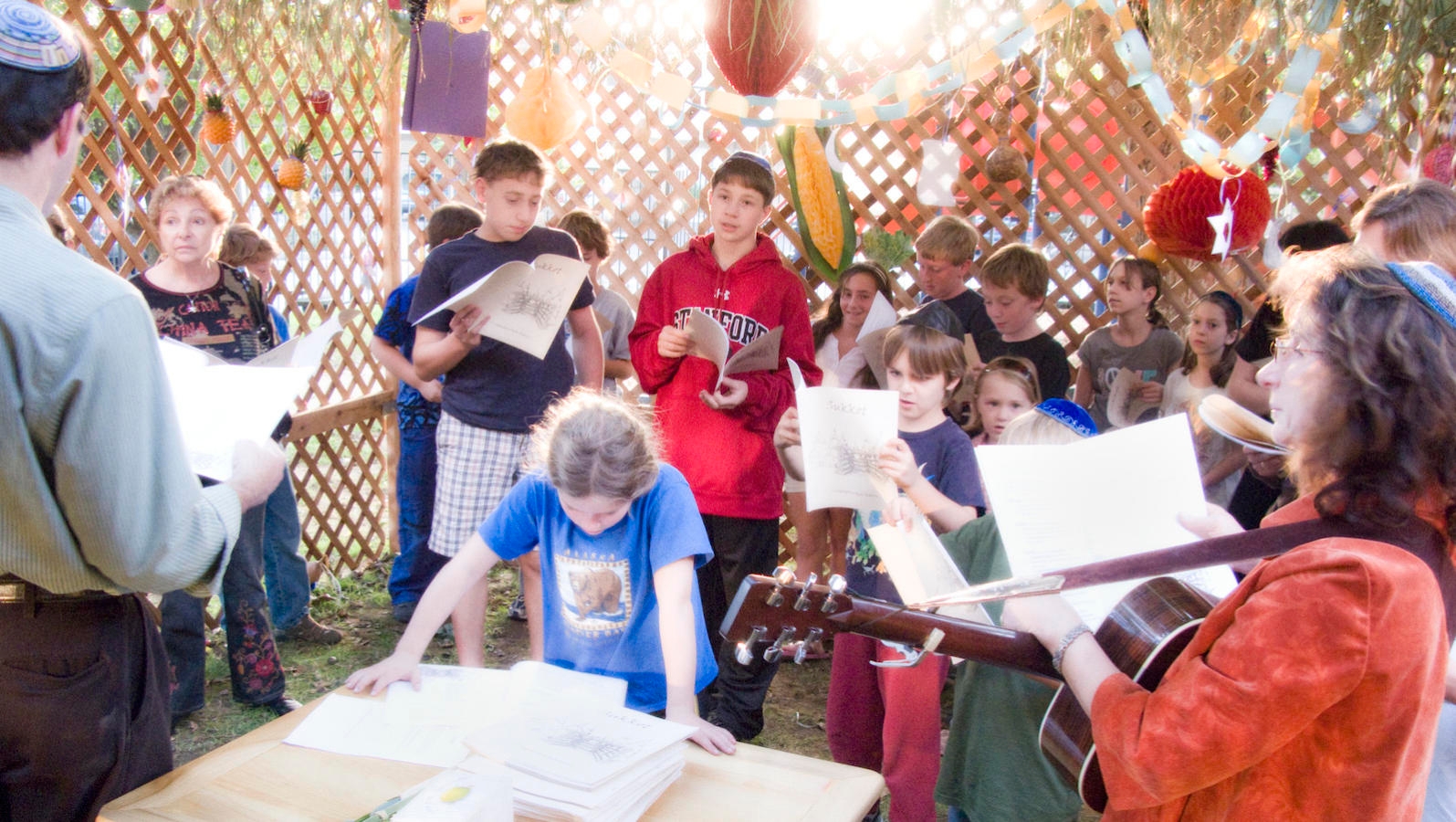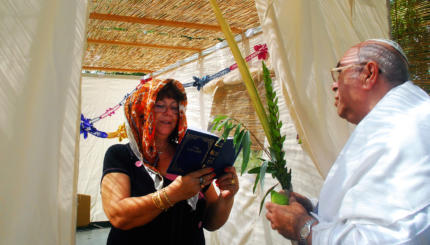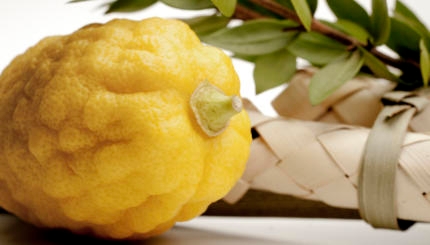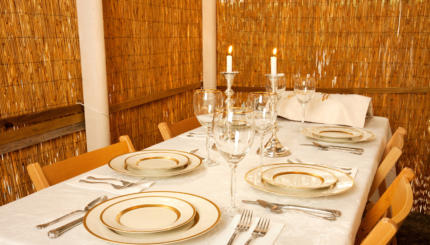The central symbol of Sukkot is the eponymous sukkah, the hut in which Jews are supposed to eat and dwell during the holiday in remembrance of the wanderings of the Jews in the desert after the Exodus from Egypt. Many Jews build their own sukkot (plural of sukkah) in their backyards or elsewhere on their property, while in many cases a communal sukkah at a synagogue or community center takes the place of the family sukkah.
Here are the parts of the service you can expect to see at a Sukkot morning service in synagogue:
- Structure of the Service
- Shaking the Lulav
- Hallel and Hoshanot
- Reading from Ecclesiastes
- Hoshanah Rabba Prayers
Communal religious services on Sukkot can take place inside of the sukkah, a a synagogue, or any place they are usually held.
Communal Morning Prayer Service
Sukkot morning prayer services traditionally have a similar structure to Shabbat services. They begin with the morning prayer service, Shacharit, continuing to a Torah service and, depending on the type of synagogue and denomination, concluding prayers.
With your help, My Jewish Learning can provide endless opportunities for learning, connection and discovery.
Many congregations will use nusah, or prayer melodies, that are sung only on Sukkot.
During the service there are also several additional components that are specific to Sukkot.
Lulav and Etrog
A major focus of public worship on Sukkot is the waving of the “four species” during communal prayer services. The origin of this custom is a verse in the Torah, according to which the Israelites are commanded to “take the produce of goodly trees, branches of palm trees, boughs of leafy trees, and willows of the brook and you shall rejoice before Adonai your God seven days” (Leviticus 23:40).
The rabbinic tradition understood this to mean that one should acquire a lulav and an etrog. A lulav is a palm branch; the branch is placed in a holder together with sprigs of myrtle (aravot) and willow branches (hadasim). These three are collectively referred to as the lulav, since the palm is the dominant feature. The etrog is a variety of citrus fruit also known as a citron.
The lulav and etrog are picked up and symbolically waved at different parts of the morning service. When they are all held together and shaken in prayer they are viewed as fulfilling the verse in the book of Psalms (Chapter 35:10), which declares that “All of my bones shall proclaim, ‘O Adonai, who is like You?’” (Leviticus Rabbah 30:14). In this manner, it is symbolic of devoting one’s entire body to the worship and praise of God.
Hallel and Hoshanot
The lulav and etrog are picked up and blessed for the first time during the synagogue services at the beginning of a section of prayers called Hallel, or Psalms of Praise (Psalms 113-118). The lulav and etrog are held in one’s hands throughout the joyous singing and recitation of these psalms and are waved in the six directions at three different points in the chanting of these psalms.
The lulav and etrog are set aside during the reading of the Torah but picked up again toward the end of the morning synagogue services for a unique ritual called the Hoshanot. The Hebrew word hoshanah means “please save (us)” and is a series of as many as seven liturgical poems calling upon God to rescue and redeem the Jewish people, primarily by sending rain.
To demonstrate the sincerity and seriousness of the worshippers, the Ark is opened and a Torah is removed from the ark. In a further bid to gain divine favor, everyone carrying a lulav and etrog joins a procession that circles the inside of the sanctuary of the synagogue, chanting and waving his or her lulav and etrog. This procession circling the sanctuary is called a hakkafah (“circling”). A different hoshanah prayer is recited every day of the festival.
Kohelet (Ecclesiastes)
Many communal Sukkot prayer services include a reading from Kohelet, or Ecclesiastes, during a Sukkot service in the morning or evening. The book is found in the Writings section of the Bible.
Kohelet, the authorship of which is commonly attributed to King Solomon, was chosen as a reading because of its linked themes with Sukkot. As Kohelet talks about the futility of life and the transience of existence, the sukkah is a temporary dwelling that can remind people that nothing is permanent.
The book, chanted like a Torah portion, takes about twenty to thirty minutes overall. Some congregations do not read Kohelet, or just read selected passages.
Hoshanah Rabbah and Shemini Atzeret
The seventh day of Sukkot is a semi-holiday in its own right. Still counted among the days of hol hamo’ed (intermediate days of the festival), this day is called, Hoshanah Rabbah or the “great hoshanah.” Hoshanah Rabbah was viewed by the rabbis as a mini-Yom Kippur, a day on which the entire Jewish community is judged by God to be worthy or not of the seasonal rains.
All seven hoshanot prayers are recited in seven processions around the sanctuary. At the conclusion of this, a special ritual is conducted in which the branches of the willow are struck upon the ground. This is a symbolic attempt to rid ourselves of any remaining sins (the leaves representing these transgressions) that might influence God’s decision to send the seasonal rains. For many Jews, Hoshanah Rabbah is the last day one shakes the lulav and etrog and dwells in the Sukkah (though a number of traditional Jews continue to dwell in the sukkah through Shemini Atzeret). On the evening following Hoshanah Rabbah begins the festival of Shemini Atzeret.
Adonai
Pronounced: ah-doe-NYE, Origin: Hebrew, a name for God.
etrog
Pronounced: ETT-rahg, Origin: Hebrew, a citron, or large yellow citrus fruit that is one of four species (the others are willow, myrtle and palm) shaken together as a ritual during the holiday of Sukkot.
lulav
Pronounced: LOO-lahv (oo as in boo), Origin: Hebrew, a bundle of branches representing three species -- willow, myrtle and palm -- which are shaken together with the etrog on Sukkot.
sukkah
Pronounced: SOO-kah (oo as in book) or sue-KAH, Origin: Hebrew, the temporary hut built during the Harvest holiday of Sukkot.
Sukkot
Pronounced: sue-KOTE, or SOOH-kuss (oo as in book), Origin: Hebrew, a harvest festival in which Jews eat inside temporary huts, falls in the Jewish month of Tishrei, which usually coincides with September or October.
Torah
Pronunced: TORE-uh, Origin: Hebrew, the Five Books of Moses.



